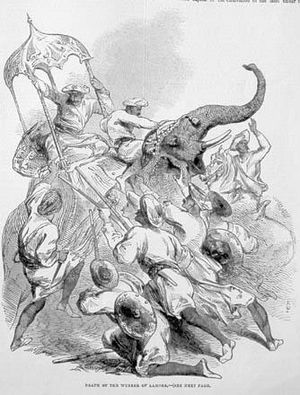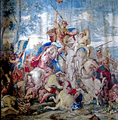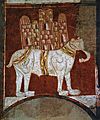War elephant facts for kids
A war elephant was a powerful elephant specially trained for battle. These huge animals were guided by human riders. Their main job was to charge at enemies, trampling them and breaking their battle lines. They were like living tanks of ancient times!
War elephants were first used in India. From there, their use spread to other parts of the world. Famous leaders like Pyrrhus of Epirus and the armies of Carthage used many of them. The famous general Hannibal even crossed the mighty Alps mountains with his war elephants to fight against Rome.
Over time, how armies fought (their military tactics) changed. This made war elephants less useful in battles, especially in the west. By the 19th century, the invention of cannons made war elephants almost useless in combat. After that, elephants were still very helpful for heavy construction work.
Contents
History of War Elephants
Early Use in India
War elephants first appeared in ancient India. People there learned to train these massive animals for fighting. They were very effective in battles, helping armies win important victories.
Elephants in Ancient Wars
The idea of using elephants in war spread from India to other places.
- Pyrrhus of Epirus, a Greek king, used war elephants in his battles. His enemies were often scared by these large animals.
- The armies of Carthage, a powerful city in North Africa, also trained war elephants. They used them against the Roman Republic.
- The most famous Carthaginian general, Hannibal, led many war elephants across the Alps. This was an amazing feat, showing how important these animals were to his army.
Why War Elephants Stopped Being Used
Over many centuries, armies developed new ways to fight. These new military tactics made war elephants less effective. Soldiers learned how to deal with elephant charges.
The biggest change came with the invention of cannons. Cannons could fire powerful shots that could easily injure or kill an elephant. This made war elephants too risky to use in battle. By the 19th century, they were no longer used for fighting. However, elephants continued to be valuable for moving heavy things and for construction.
Images for kids
-
War elephants depicted in Hannibal Barca crossing the Rhône, by Henri Motte. Made in 1878.
-
War elephants during Battle of Gaugamela.
-
A Carthaginian shekel, dated 237-227 BC, depicting the Punic god Melqart (equivalent of Hercules/Heracles), most likely with the features of Hamilcar Barca, father of Hannibal Barca; on the reverse is a man riding a war elephant
-
Roman marble sarcophagus depicting the Triumph of Bacchus returning from India, with soldiers atop war elephants, 2nd century AD, similar to a later sacrophagus with the same theme
-
Battle of Zama by Henri-Paul Motte, 1890
-
A medieval Armenian miniature representing the Sassanid Persians War elephants in the Battle of Vartanantz.
-
The Khmer army waged war with elephants against the Cham in the 12th century.
-
"The Great Battle of Yuthahatthi" - Siamese King Naresuan fights the Burmese crown prince near Suphanburi in Jan. 1593.
-
During World War I, elephants pulled heavy equipment. This one worked in a munitions yard in Sheffield.
-
Engraving of the Battle of Zama by Cornelis Cort, 1567.
-
Gajashaala or elephant's stable in Vijayanagara, India, built during the reign of Vijayanagar Empire.
See also
 In Spanish: Elefante de guerra para niños
In Spanish: Elefante de guerra para niños

















